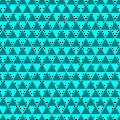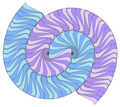Teselace

Teselace povrchu (z angl. tesellation, mozaikování, parketování) je vyplnění roviny pomocí jednoho nebo více geometrických útvarů, bez překrývání a bez mezer. V matematice lze pojem teselace zobecnit i na vyšší rozměry (např. teselace prostoru).
Teselace, která má opakující se vzor, se nazývá pravidelná.[1] Někdy se takto nazývají pouze teselace s pravidelnými mnohoúhelníky všechny stejného tvaru a tzv. polopravidelné teselace s pravidelnými mnohoúhelníky více než jednoho tvaru. V tom případě musí být útvary u každého vrcholu stejně uspořádané. Teselace, která není tvořena opakujícím se vzorem, se nazývá nepravidelná.
Skutečně využívanými teselacemi jsou různé obklady vytvořené pomocí desek z různých materiálů (například keramické obklady). Takové teselace mohou být pouze dekorativní vzory, nebo mohou mít jiné funkce, jako je poskytování odolnosti či vodotěsnosti podlahové dlažbě nebo tapetám.[2] V historii byly používány již ve starověkém Římě a v islámském umění,[3] jako například dekorativní obklady paláce Alhambra. Ve dvacátém století pak často využíval teselace ve svých dílech nizozemský umělec M. C. Escher.[4][5] Teselace se někdy používají jako dekorativní efekt při vyšívání. Často se také nacházejí v přírodě, například jako hexagonální teselace ve včelích plástvích.[6]
Příklady
- Trojúhelníková síť, jedna z pravidelných teselací roviny.
- Zkosená trihexagonální síť, polopravidelná teselace
- Polopravidelná teselace, která je ale vytvořena pomocí nepravidelných pětiúhelníků
- Včelí plástev je přírodní hexagonální teselace
- Voderbergova teselace
- Střídavá osmiúhelníková teselace v hyperbolické geometrii.
Odkazy
Reference
V tomto článku byl použit překlad textu z článku Tesselation na anglické Wikipedii.
- ↑ Teselace v encyklopedii MathWorld (anglicky)
- ↑ Basilica di San Marco [online]. Basilica di San Marco [cit. 2013-04-26]. Dostupné v archivu pořízeném dne 2015-09-23.
- ↑ DUNBABIN, Katherine M. D. Mosaics of the Greek and Roman world. [s.l.]: Cambridge University Press, 2006. S. 280.
- ↑ GERSTEN, S. M. Introduction to Hyperbolic and Automatic Groups [online]. University of Utah [cit. 2015-05-27]. Dostupné online.
- ↑ LEYS, Jos. Hyperbolic Escher [online]. 2015 [cit. 2015-05-27]. Dostupné online.
- ↑ http://www.rozhlas.cz/leonardo/zpravy/_zprava/jak-vznikaji-sestiuhelnikove-vceli-plastve--1238086 - Jak vznikají šestiúhelníkové včelí plástve
Související články
- Pravidelná teselace
- Voronojova teselace
- Planimetrie
- Mnohoúhelník
Externí odkazy
 Obrázky, zvuky či videa k tématu teselace na Wikimedia Commons
Obrázky, zvuky či videa k tématu teselace na Wikimedia Commons
Média použitá na této stránce
Autor: Ian Alexander, Licence: CC BY-SA 3.0
Islamic mosaic — ceramic tile tessellations — in Marrakech, Morocco.
* KaleidoTile, Topology and Geometry Software, Jeff Weeks Hyperbolic plane regular tiling: t0(4 3 3)
Autor: R. A. Nonenmacher, Licence: CC BY-SA 4.0
Dual Semiregular Tiling V3-3-3-3-6 (Floret Pentagonal)
(c) Arthur Baelde, CC BY-SA 3.0
Wheher triangular or hexagonal, all tiles of this tessellation are convex regular polygons edge‑to‑edge. Out of the three colours of surfaces, one is specific to the hexagons, whereas one or the other of the lightest two colours fills each triangular tile. Every hexagon adjoins six triangles, three of one colour, three of the other. Every triangle adjoins three tiles: either three triangles or two triangles and one hexagon. A common edge of two adjacent tiles always separates two different colours.
This tiling is periodic. All its tiles have the same side length which, multiplied by 7, becomes the side length of a rhombic repetitive pattern. Its sides are parallel to two sides of a triangular tile. Its area is the one of 7 × 7 × 2 = 98 triangles. Such a pattern can contains 5 entire hexagons, four halves of hexagons, plus 7 × 8 = 56 equilateral triangles. So its area can be seen as the area of the following number of triangles: (5 + 4/2 ) 6 + 7 × 8 = 7 (6 + 8).
Such a pattern, formed by two equilateral triangles edge‑to‑edge, can be transformed into a regular hexagonal pattern of same area, of which two sides are parallel to the large diagonal of the repetitive rhombus. So this image is classified within Category:Honeycombs (geometry).












